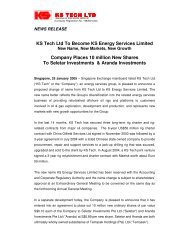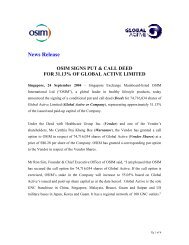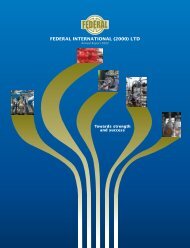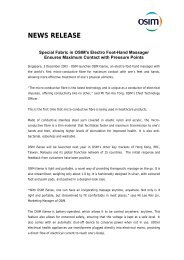Notes to Financial Statements
Notes to Financial Statements
Notes to Financial Statements
- No tags were found...
You also want an ePaper? Increase the reach of your titles
YUMPU automatically turns print PDFs into web optimized ePapers that Google loves.
Middle East Development Singapore Ltd.Annual Report 2008 43<strong>Notes</strong> <strong>to</strong> <strong>Financial</strong> <strong>Statements</strong>30 June 20082 SUMMARY OF SIGNIFICANT ACCOUNTING POLICIES (Cont’d)IMPAIRMENT OF ASSETS (Cont’d)Recoverable amount is the higher of fair value less costs <strong>to</strong> sell and value in use. In assessing value in use, theestimated future cash fl ows are discounted <strong>to</strong> their present value using a pre–tax discount rate that refl ects currentmarket assessments of the time value of money and the risks specifi c <strong>to</strong> the asset.If the recoverable amount of an asset (or cash generating unit) is estimated <strong>to</strong> be less than its carrying amount, thecarrying amount of the asset (or cash generating unit) is reduced <strong>to</strong> its recoverable amount. Impairment losses arerecognised as an expense immediately in profi t and loss.Where an impairment loss subsequently reverses, the carrying amount of the asset (or cash generating unit) isincreased <strong>to</strong> the revised estimate of its recoverable amount, but only <strong>to</strong> the extent that the increased carryingamount does not exceed the carrying amount that would have been determined had no impairment loss beenrecognised for the asset (or cash generating unit) in prior years. A reversal of an impairment loss is recognisedimmediately in profi t and loss.ASSOCIATES - An associate is an entity over which the group has signifi cant infl uence and that is neither asubsidiary nor an interest in a joint venture. Signifi cant infl uence is the power <strong>to</strong> participate in the fi nancial andoperating policy decisions of the investee but is not control or joint control over those policies.The results and assets and liabilities of associates are incorporated in these fi nancial statements using the equitymethod of accounting, except when the investment is classifi ed as held for sale, in which case it is accountedfor under FRS 105 Non-current Assets Held for Sale and Discontinued Operations. Under the equity method,investments in associates are carried in the consolidated balance sheet at cost as adjusted for post-acquisitionchanges in the Group’s share of the net assets of the associate, less any impairment in the value of individualinvestments. Losses of an associate in excess of the Group’s interest in that associate (which includes any longterminterests that, in substance, form part of the Group’s net investment in the associate) are not recognised,unless the Group has incurred legal or constructive obligations or made payments on behalf of the associate.Any excess of the cost of acquisition over the Group’s share of the net fair value of the identifi able assets, liabilitiesand contingent liabilities of the associate recognised at the date of acquisition is recognised as goodwill. Thegoodwill is included within the carrying amount of the investment and is assessed for impairment as part of theinvestment. Any excess of the Group’s share of the net fair value of the identifi able assets, liabilities and contingentliabilities over the cost of acquisition, after reassessment, is recognised immediately in profi t or loss.Where a group entity transacts with an associate of the Group, profi ts and losses are eliminated <strong>to</strong> the extent of theGroup’s interest in the relevant associate.PROVISIONS – Provisions are recognised when the Group has a present obligation (legal or constructive) as a resul<strong>to</strong>f a past event it is probable that the Group will be required <strong>to</strong> settle that obligation, and a reliable estimate can bemade of the amount of the obligation.The amount recognised as a provision is the best estimate of the consideration required <strong>to</strong> settle the presen<strong>to</strong>bligation at the balance sheet date, taking in<strong>to</strong> account the risks and uncertainties surrounding the obligation.Where a provision is measured using the cash fl ows estimated <strong>to</strong> settle the present obligation, its carrying amount isthe present value of those cash fl ows.When some or all of the economic benefi ts required <strong>to</strong> settle a provision are expected <strong>to</strong> be recovered from a thirdparty, the receivable is recognised as an asset if it is virtually certain that reimbursement will be received and theamount of the receivable can be measured reliably.WARRANTIES – Provisions for warranty costs are recognised at the date of sales of the relevant products, at themanagement’s best estimate of the expenditure required <strong>to</strong> settle the Company’s obligation.
















